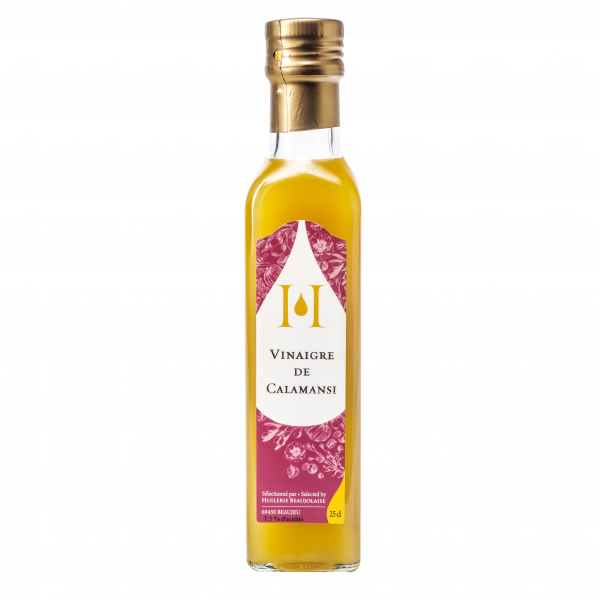
The Aromas of Calamansi Vinegar
The pulp of calamansi has a tangy taste, reminiscent of passion fruit and grapefruit, with a slight bitterness. Its zest, on the other hand, carries a pleasant fragrance and a mild flavor similar to that of Kumquat (a Japanese citrus). Calamansi oil, with its harmonious blend of aromas, tastes, and scents, is widely used in cooking to add an exotic touch to dishes, sauces, marinades, and desserts.
What is Calamansi?
Calamansi is a small, round citrus fruit native to Southeast Asia. Smaller than a key lime, calamansi is a treasure trove of health and well-being benefits. Highly utilized in Filipino cuisine, its slightly bitter taste and multiple flavors resemble those of mandarin oranges, key limes, and pink grapefruits. Originating from a cross between Kumquat and mandarin orange trees, calamansi is primarily consumed when it is still young and has green skin. As it matures, its color changes to orange, resembling the appearance of a clementine.
The Making of Calamansi Vinegar
To obtain calamansi vinegar, the fruits are harvested at full maturity, then combined with vinegar before being sweetened with cane sugar to facilitate the fermentation of fruit juice. This fruit juice fermentation process involves two steps: first, an alcoholic fermentation where the natural yeasts present in the juice transform the sugar into alcohol, turning the juice into wine. Next, the natural bacteria in this fruit wine convert the alcohol into vinegar, without undergoing pasteurization. The resulting vinegar is then filtered before being bottled.
How to Use Calamansi Vinegar in Cooking?
Calamansi vinegar is the exotic equivalent of lemon juice, but with an intensity that makes it unique. Use it to enhance your raw vegetable salads by adding a tangy freshness. Incorporate it into your tabbouleh for an exotic twist or to accentuate the flavor of your hot or cold fish and seafood dishes. It is also widely used in pastry, delicately flavoring your desserts. It is recommended to store it in a cool place and shake it before use.
Some Suggestions for Using Calamansi Vinegar
- Chicken Slices with Calamansi Vinegar: Slice your chicken into small strips and place them in a bowl. In a separate bowl, mix 8 tablespoons of Calamansi vinegar with salt and pepper. Cover and let it marinate for 30 minutes. Heat olive oil in a pan, then add the marinade with the chicken pieces. Serve hot with grated carrots.
- Calamansi Vinegar Mousse: Soften gelatin in cold water. Pour 2 tablespoons of Calamansi vinegar into a blender, add sugar, and mix. Off the heat, dissolve the squeezed gelatin by stirring. Whip the egg whites with a pinch of salt. Gently fold the gelatinized juice into the whipped egg whites. Divide the mousse into 4 tall glasses. Chill for at least 3 hours.
- Dorado Carpaccio: Start by blanching your watercress in boiling water. Cut your basil leaves, squeeze a lime, and crush everything in a mortar with olive oil. Squeeze the watercress and your mixture through a sieve to collect the juice. Toast hazelnuts in a small pan, then slice your dorado fillets into thin slices. Arrange them on your plate with your green oil, season everything with a generous drizzle of calamansi vinegar, and add your toasted hazelnuts.
| Allergen | Absence |
|---|---|
| Native country | ALLEMAGNE |
| Ingredients | calamansi juice, vinegar out of spirit, cane sugar. |
| Nutritional Info | VN Energie pour 100 g (energy for 100g) : 583 kJ / 137 kcal VN Matière grasse (fat) : <0.5 g Dont acide gras saturés (of which saturated fat) : <0.1 g VN Glucides (carbohydrate) : 28 g Dont sucres (of which sugars) : 28 g VN Protéines (protein) : <0.5 g Vn Sel (salt) : 0 g |
 Français
Français 